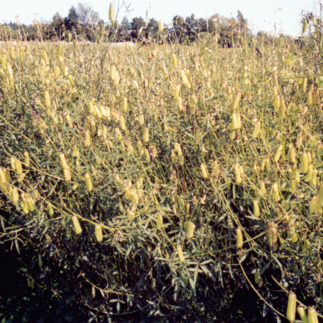Herbs or shrublets, erect, to 1.5 m tall. Branches ribbed, pubescent when young but glabrescent. Stipules absent. Leaves 3-foliolate; petiole 1-3 cm; petiolules ca. 1 mm; leaflet blades linear to linear-lanceolate, 5-9(-12) × 0.5-1 cm, abaxially sparsely pilose, adaxially glabrous, base broadly cuneate, apex acuminate and mucronate. Racemes terminal, 10-15 cm, 10-15-flowered, lax; bracts minute. Pedicel 3-5 mm; bracteoles inserted at base of calyx tube, similar to bracts. Calyx subcampanulate, ca. 4 mm, 5-lobed, glabrous; lobes triangular. Corolla pale yellow or white, exserted far beyond calyx; standard oblong, 0.8-1.2 cm, base with 2 appendages; wings obovate, ca. 1.3 cm; keel 1.7-2.3 cm, longer than wings, shortly rounded, beak rather long and projecting. Ovary subsessile. Legume oblong, 4-7 × 1.5-2 cm, 20-30[-100]-seeded, sparsely pubescent. Seeds pale yellow to orange, reniform, smooth. Fl. Aug-Oct, fr. Nov-Dec.
More
An erect annual, or short lived perennial. It grows 0.5-2.7 m tall. There are fine hairs on the stems. The leaves have 3 leaflets. These are narrow and 5-13 cm long by 0.5-3 cm wide. They are slightly hairy underneath. The flower clusters are 10-50 cm long, with many flowers which are 2 cm long. They are yellow with red streaks. The wings of the flowers have a purple mark at the base. The fruit is like a cylinder and is 5-7 cm long by 1.5-2 cm wide.
Mainly in damp grassland, especially in floodplains, depressions and along edges of swamps and rivers, but also in deciduous bushland, roadsides and fields. It grows in open localities with adequate sunshine at elevations of 300-2,000 metres.
More
A tropical plant. In Papua New Guinea is grows from 30 m to 1,800 m altitude. It is mostly on plantations. In Zambia it grows in savannah. In southern China it grows in shady places with thin soil.

